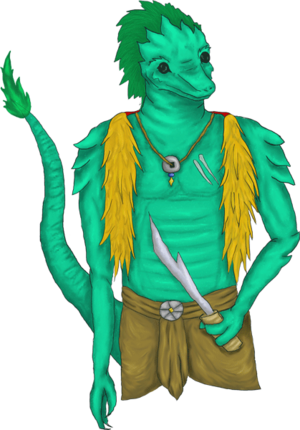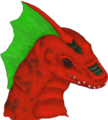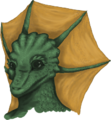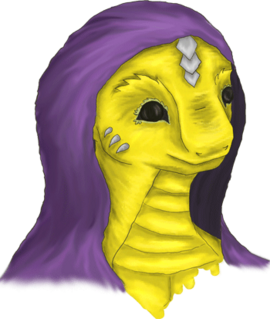Takula
| Takula tah - coo - lah | |
|---|---|
| Plural: | Takula |
| Scientific Name: | draco sapiens lacerta |
| Homeworld: | Ramath-lehi |
| Characteristics | |
| Height: | 1.83 m (6 ft) - 2.53 m (8 ft 3 in) |
| Weight: | 68 kg (150 lbs) - 113 kg (250 lbs) |
| Colouration: | |
| Creation Notes | |
| The Takula are at least 6 feet tall (unless they are of the skink mutation). Skinks are around 3 feet to 4'6" feet high. Their colours are specific, they include, blue, orange, red, green, purple, yellow and magenta. They always have one main colour and a second colour. The second colours is for their fins and scale patterns. They do not have to have a secondary colour though, and some times they have other colours as well aside from their main ones.
Takula are usually bipedal and their quadruped form is similar to a Earth tiger's or dire wolf's build when you consider their size. The quadruped form of the skink however is more akin to small dog or lizard. The males are some what simple minded, only a few older more experiences males are considered intelligent by modern standards. They are not stupid but they are more physical than mental, some can do magic however they are always violent forms of magic. They are never overly great at them either. Females are smarter, more magical and they are often priests although this is not an absolute rule. They nearly always have either a magic trade or a mental trade, yet they sometimes can chose to be more physical although the males always out rank them in this. The skinks are however good at both but great at neither, they are smart and quick making them good hunters and they can do magic too. They are not physical strong though and rely more on guile and agility, they are most commonly shamans or hunters, yet they can do anything the tribe needs or wants. | |
The Takula are a Pendragon subspecies that has been separated in the more remote jungles and dense forest parts of Ramath-lehi. They have evolved to be far more lizard like than any other species, being cold blooded and scaled. They are large, powerful and brooding creatures shrouded in mystery and legend.
Contents
Description
The Takula are a small subspecies of Pendragons that are not less evolved but defiantly more acclimatized to certain areas.
They are almost completely reptilian, are cold-blooded and have various other reptile adaptations.
Takula live in packs and tribes but may also be found leading solitary lives. In these tribes they usually have very specific roles they fill out. The tribes themselves are somewhat violent and fight quite often, taking food and prisoners from each other. A strange oddity is that the captured Takula immediately ally with their captor's tribe, completely switching sides. Therefore tribe wars can often be very bizarre with large amount of the tribe members completely switching around.
They are naturally taller than average Pendragons (six feet tall is the minimum height for a Takula) and it not uncommon for them to be a total of eight feet tall when fully grown. The males being naturally more brutish and larger than females but the females are by far more intelligent. They have broad necks, shoulders and all in all resemble reptiles far more than any other creature.
Takula have no fur whatsoever. They are covered in scales that are often very bright and vivid in colours that range from tropical greens to vibrant oranges and reds. Their hands are large and made up of two thick fingers and an opposable thumb. All fingers have wicked two-inch claws on them that can be re-grow if broken and are very helpful for climbing trees and stone surfaces. Their heads often vary quite a bit from individual to individual. They range from having different sized horns to brightly coloured fins or even quills running down the backs of their heads. Takula all have thick tails with the same rules of tail flames as a normal Pendragon, some however have spikes and/or extruding bones showing.
They have a few mutations from the reptile world that some of them possess, some can change the colour of their scales to camouflage themselves in their environment with frightening effectiveness. Some have projectile tongues that they can use, some can even climb up walls thanks to mutations in the finger scales. They all however, can swim very well and can last for extreme amounts of time underwater due to their vast lung capacity. There are some more rare mutations among Takula, among these are poisonous bites, tongues which with they can "see" with, like a snake, and the strangest is that some are born with a strange feathery covering. The majority of these feathers resemble feathery down, which go away around a month after hatching. The larger feathers which actually look like the feathers one would see on a bird are only located on the tail area, the head in a sort of "mohawk", and some around the arms. This "feather mutation" only occurs in about 1 of every 500 Takula, and is considered to be quite attractive. There is a small mutation which is barely noticeable, some Takula are not as small as skinks, but around the same size as the average Pendragon.
Takula can be very slow and dull witted. However this usually only applies to the males of the subspecies. Though if you cross their paths in the morning when they haven’t had time to bask in the sun, then they all are. They are not stupid though and posses a certain cunning and survivability instincts that not only keep them alive but make them formidable. They can speak English but not perfectly and can sometimes struggle with the language. Takula do not naturally know how to speak Ramathian but the smarter ones can learn it. Takula can write as well but their written language is very simple. They write using a form of hieroglyphics (pictographs).
Skinks
About one in four Takula are born with a defect that makes them very small, these defected ones are only about three feet high but are much more dexterous and faster than the average Takula. These smaller Takula are commonly called "skinks." Skinks are smarter than average, being able to build and work more complex ideas in their heads. Since they are smarter, they often fill out the role of priests or shamans in the tribe. Apart from females, they are the only ones capable of handling magic.
Sexual Dimorphism
The Takula do not have many noticeable differences between males and females. While the sexes can often be distinguished by their size, they lack any other traits that make it easy for non-Takula to tell the sexes apart. Takula females do not have breasts, and therefore do not suckle their young.
Images
Merak Tribe characteristics.
SujaVa Tribe characteristics.
VejaTci Tribe characteristics.
Dusa Doujpeumt Clam characteristics.
EkaTci Tribe characteristics.
HarkCi Tribe characteristics.
Reproduction and Social Life
The female Takula go into season once a year around Tria. She and other females will lay eggs in specific areas that are similar to ponds, these are called spawning pools. The males will then fertilize the eggs and a protective layer of mucus will form over the pool keeping them insulated and safe from simple predators.
After 12 weeks the eggs will begin to hatch and small Takula will start to swim around in the pool and eat what ever remains of the high protein shells and any still born. After this period, which normally lasts three days, the Takula spawn will break free from the pools and live as a small pack together in the clan. These clans are often very close knit and the members share a unique bond that is very hard to break.
This very impersonal and somewhat grizzly method of reproduction has its flaws but it ensures a higher survivable rate in the harsh jungle conditions. Single pairs of Takula can still breed though with the female laying her eggs with the male fertilizing them. This mass version of reproduction is only a survival adaptation, they are perfectly capable of reproducing in the traditional way. (Mass fertilization is only for survival purposes where higher numbers are needed to secure the survival of the tribe.) Their naturally violent nature and adrenaline junkie attitude can cause quite a bit of death among the young, another reason for the high birth method.
The males are very aggressive and typical alpha males when in their teens. Often they get into fights and scrap with others. The older males are more thoughtful and very strong, they do either the hunting and fighting or the heavy building. They often use simple weapons like clubs and spears to hunt, while the skinks use light bows.
The females when young, either start to learn useful trades that the males are incapable of doing. Sometimes they practice magic or some kind of telepathy. However they may become priests or shamans. Often the women are more important than males and have a higher place in the society. The village leader is always a powerful magical female who is often very old, otherwise known as the matriarch.
The skinks are the tribes all rounder, when there is a shortage of male warriors they can hunt with adequate skill yet when there is a shortage of females they are capable magic users and smart enough to run the tribe. They usually just build or do minor hunting, or they collect things that are harder to find such as metals and herbs. All Takula have a liking for shiny metals and value them very highly especially gold, which is what they build a lot of their jungle buildings out of, that and stone.
The Takula also like to expand and have war games, in some ways they hold complex gladiatorial contests and in other less cultured places they brawl and bet. They are very competitive and often play any games to a very serious extent, they also build. They often build large temples and structures in the jungle for their cities and also to glorify their god. They do hide these building though and often build them in very remote parts of the Jungle where few people who do not know there lands will never see them.
Yet when they are not engaging in violence or showing their structural skills off they are very versatile, with a keen eye for fine jewellery and sculptures their towns and villages are often filled with totems and statues of various designs.
Social Structure
Commons roles found within the tribes.
Hunter: Many of the males in the tribe are hunters. Responsible for bringing in most of the tribes food. They also become the tribes main warriors when engaged in warfare with an opposing tribe.
Guard: Males and some females will take positions as guards to either the spawning pools or to priestesses.
Gatherer: Often Skinks of the tribe, this group travels fairly far from the tribe to gather herbs, precious metals and edible plant life.
Builder: Responsible for building temples and living quarters for the tribe. Usually the brightest males of the tribe who have an excellent understanding of stonework.
Scout: Very useful during war times, often Skinks who can travel quickly without being detected. They often scout out the location of other tribes but other of large animals to hunt. They are sometimes sent on missions to gather certain pieces of information.
Game Master: Each tribe has one, often the oldest male. He is responsible for hosting the inner tribe competitions. He is also seen as being responsible as keeping violence down within a family tribe by providing outlets for their aggression.
Shaman: Not has skilled as the Priestesses but usually a Takula that shows minor mastery of magical abilities will become a Shaman. They are needed for their healing abilities and often specialize in some sort of magical deed.
Priest/Priestess: Most often these are female, however on the rare occasions of a male presenting strong telepathic ability they too are welcome to Priesthood. These are the most respected members of the tribe who are meant to be protected at all cost.
Habitat
They may be found in deep jungles and warm areas and like moisture far more than dry land. They can often be found wandering out of their usual territory but only when the weather is warm.
Known Tribes
| Location | Social Class | |
|---|---|---|
| Dusa Doujpeumt Clan | Unknown | Lowerclass |
| EkaTci Tribe | Working Class | |
| HarkCi Tribe | Working Class | |
| Merak Tribe | Lower Working Class | |
| SujaVa Tribe | Lower Working Class | |
| VejaTci Tribe | Working Class |
Religion
The Takula are very ritualistic and theirs lives often revolve around the tribe shaman and the female priestesses. The Takula have their own god but may also worship more common deities. Their god is a giant reptile like snake with a feathery mane called Sykyu which some what promotes violence and sacrifices. It is not uncommon for the Takula to kill a large animal every day in honour of their god. Tribes turn to their priestesses for guidance and instruction on what to do on important dates as well as the best ways to worship. Be it through pray, sacrifice or victory on the battlefield.
An important aspect of the Takula religion is the use of colour, especially in the more tropical tribes. Takula love to dye fabrics vibrant colours to match their own scale colours. Purple denotes religious purity and devotion. Yellow is a sign for excellence and achievements. While Takula wear very little clothing but when they do wear cloth it always has meaning denoted by it's colour.
The priestess females, the religious leaders of the tribe, are usually very powerful with their minds, often being extraordinary telepaths. They can even communicate with the entire tribe with just their mind. The most powerful ones travel on a throne that they move with their telekinetic powers. However they are always occupied by a bodyguard team. Being too important to be put in danger.
Marriage Traditions
The Takula do not all get married, only the higher class members do, such as the priestess females and the shamans. The lower class members of the tribe just have a smaller, much less celebrated version of this. When he higher class citizens decide to get married, it is deemed a great celebration for the tribe and a time to show of its power.
The couple are given a feast that the whole tribe is invited to where the lead male, who is usually a champion of a battle or contest, hunts for the main centre piece. The male will capture it alive and slaughter it personally at the feast in honour of the female. The female can, if she wishes reject the prize and demand he presents her with a more worthy prey. This does not happen often however since the natural competitiveness of males means they usually go for large prey.
After the feast the tribe shamans perform a ceremony and spell which make the auras of the two become luminous and glow. The couple stand together in an embrace as they shamans continue the spell which makes the auras of the two intertwine in a mass of colour. Some very traditional Takula believe that the colour is significant but most just enjoy the show. The couple then are given the blessing of the tribe and a new home is usually pre-built for them which they will live in together. For the first week after their marriage they are treated as king a queen in what is similar to a honey moon period.
History
The Takula were originally just normal Pendragons, they were some what reptilian at the start but not to the degree they are now. They chose to make their home in the darker jungles and swamps lands of the world, enjoying the diversity of life they found there. However they were inept at surviving at first, fighting and attacking each other over food and resources since few were skilled hunters then. This was the start of there aggression and violence.
As the centuries moved by the Takula become increasingly more reptile like, they were all completely scaled and they were begging to show the first signs of cold blooded creatures. They were now capable of surviving but they had not lost their raiding habits, often attacking for food instead of capturing it. Eventually though main tribes began to control areas, each with its own unique traits that they had evolved. They slipped deeper into he jungles and settled their power where they felt safest yet also furthest away from the cold.
Soon their villages began to become slightly more civilized with buildings and large golden structures hidden in the undergrowth. They discovered religion and focus most off their competitiveness and aggressive qualities into this, not only did they expand somewhat but they began to develop more advance ideas such as organized gladiatorial fights and such. Yet in 60000, Mia was harsher than ever and the cold chill spread into all but the deepest Jungles.
The Takula suffered terribly and many of them died, their numbers shrank and they disappeared into the deep jungles again. They left behind many a lost jungle ruin as a clue to their previous whereabouts but this drop in their numbers also served to hide them from the ever evolving and more civilized Pendragons who were advancing through out the world. Yet now their numbers have risen to they original levels and they have began to re appear all over the world, jungles now seeming infested with them.
It is rare for a Takula to even apply for any sort of government-issued identification. As a result, not many Takula ever make use of the Portal Transportation System, or end up getting a Khorta card. The Takula are the most technologically inept out of all of the races on Ramath-lehi. There are mixed emotions as to what the government should do with the Takula. There are some who believe that they should be sheltered from the rest of the world and have their culture preserved. Others believe that they should be forced to integrate with the rest of Ramathian society. Currently there are laws in place that prevent the destruction of the native Takula jungles, but there are not many laws regarding the preservation of their culture as a whole.
Language
The Takula can also speak another language, though they never share it with non-Takula. It is called "Takola" and it consists of not only words but hisses and clicks (depicted with an exclamation point '!') along with body language and tail movements. This makes it one of the hardest languages to learn and very hard to actually speak correctly.
See Also
| |||||||||||







